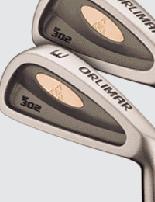GOLF EQUIPMENT
|
|
I've achieved greater average distance with the Orlimar irons simply because of its increased consistency. |
Dolinar adds "It's for the average golfer who's looking for the ability to work the ball, and to have a good sense of the ball coming off the clubface-but to get the advantage of a cast club for forgiveness. The SF 302 is aimed towards making every player's game better, but also to provide high performance for good players."
I've always been curious about exactly how golf club manufacturers really accomplish this goal, short of a clever marketing campaign and some nice looking, polished clubs. For the Orlimar SF 302, you can see it. There's a copper/tungsten mass in every club, and its position varies with the loft of each individual iron. The weight is more towards the toe on the longer irons, and more towards the heel on the 'scoring clubs.'
Dolinar says it's extremely important to concentrate the club's weight behind the ball in order to achieve maximum distance and accuracy. That's what distinguishes the Orlimar iron from the others. And the positioning of the weight on the iron helps with the player's visualization. I've used the clubs in five rounds thus far-and it's already helped quite a bit.
Dolinar continues "Varying the mass of the weight increases forgiveness. If you mishit the ball-a little bit off-center, the ball struck with the SF 302 tends to work its way back to center. Again, it's a matter of getting the weight behind the ball where you need it the most."
It's becoming the marketing cry of a number of the newer vintage equipment manufacturers that a straight game is optimal. Common sense, I guess. But Orlimar's emphasis has proven results. Including my experience.
|
The Orlimar SF 302 irons have already helped. I'm not saying they're like a magic genie in a golf bag that will automatically steer every ball towards the flag stick-but it's definitely brought more consistency to my game. The two most important categories -distance and accuracy- is where I'll comment.
I've achieved greater average distance with the Orlimar irons simply because of its increased consistency-especially on the long irons. Since the weight is closer to the toe, my natural swing tendencies don't punish me the same way that my previous clubs have. The increased weight behind the ball, together with less of a tendency to weakly turn the clubface, have given me more 'normal' distance out of my iron game. And more 'normal' distance is greater than I had before-so yes, the SF 302 has increased my overall distance.
But the greatest and most notable difference is accuracy. The ball feels much more natural off the clubface and has a noticeably straighter flight. I've been surprised to see the ball indentation on the club after a shot is still close to the toe, yet the shot's flown straight.
 It leads to a certain confidence in the clubs, which probably results in more consistent swings-because you're not worrying about getting it perfect every time. That's probably the greatest value in the Orlimar product-it allows you to make your own game better more so than the technology improves it.
It leads to a certain confidence in the clubs, which probably results in more consistent swings-because you're not worrying about getting it perfect every time. That's probably the greatest value in the Orlimar product-it allows you to make your own game better more so than the technology improves it.
I'd certainly recommend the SF 302 irons to anyone looking for more consistency, distance and accuracy. I'd also recommend them for beginning players-especially at the expense of the traditional starter set. The only problem with having new players start out with these new clubs is-they'll have no idea how hard this game really is!
Orlimar SF 302 Irons
Website: http://www.orlimar.com
Webpage for SF 302 Irons:
http://www.orlimar.com/sfirons.html
Available at Fine Pro Shops and Golf Retail Stores
Suggested Retail:
$499 (steel shaft); $699 (graphite)
Club Designer: Jesse Ortiz
Orlimar Director of Marketing: Mike Dolinar
CORPORATE HEADQUARTERS
Orlimar Golf
30826 Santana Street
Hayward, California 94544
tel (510) 476-5800
fax (510) 487 4800
 The Orlimar
The Orlimar